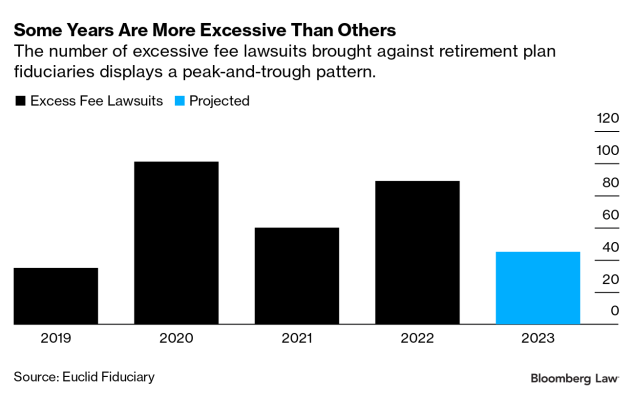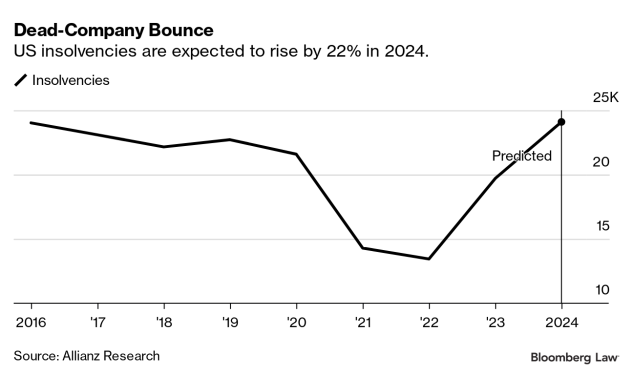Most Big Law firms are poised to report revenue and profit growth for 2023. To repeat the trick in an uncertain market in this year, managing partners will need strong performances in key practices.
Many expect strong litigation practice performances this year after courtroom activity buoyed the bottom line for plenty of Big Law firms in 2023. It’s a similar story for antitrust practitioners, who helped pick up the slack from Big Law’s most important profit centers: Mergers and acquisitions and capital markets.
It is hard to envision a successful year across the industry if M&A and capital markets practices don’t turn around. But counter-cyclical restructuring groups are poised to continue a strong run, even if transactions come back.
Here’s the outlook for four crucial practice groups as we plunge ahead in 2024.
Capital Markets and M&A
M&A practice areas are coming off their worst performances in a decade, according to data from the first nine months of 2023 compiled by Bloomberg Law. Global M&A deals through Q3 were nearly $1 trillion lower than in 2022, when transactions were nearly $1 trillion less than the booming 2021 market.
The downturn has lasted longer than managing partners expected: many had targeted the second half of 2023 for a rebound.
Well, that came and went.
Now, there are plenty of fresh calls for a rebound.
“It’s certainly our view that 2024 will be a better year than 2023, and one main reason is the inevitability of a rebound in transactional work,” said Gretta Rusanow, managing director and head of advisory services at Citi Private Bank Law Firm Group.
A more tempered prediction came from Scott Miller, co-chair of Sullivan & Cromwell, who works on nearly every type of transaction or governance matter.
Miller already sees more activity in the early stages in both M&A and capital markets. He anticipates interest rates to stabilize this year, helping to buoy more work. Two industries poised for transactions, he said, include asset management and technology, particularly around artificial intelligence.
“There’s going to be a lot of M&A and capital markets activity around the peripheries of AI,” Miller said. “There are a whole bunch of companies out there that have a piece of AI or have an AI story to tell, and there are going to be aggregators of those businesses to try and create a larger AI platform. I think you’ll see a fair amount of that beginning in the first half of 2024.”
Antitrust
If corporate transactions indeed pick up steam this year, antitrust practices will also kick into a higher gear. That’s somewhat by default: there are fewer antitrust merger reviews in a slow environment for M&A.
But antitrust lawyers at some firms have kept busy despite the M&A downturn.
The practice generally has two main drivers of work: merger review and antitrust litigation, which is either brought by the Federal Trade Commission, US Department of Justice or private plaintiffs.
Federal antitrust regulators have taken a more aggressive enforcement approach under the Biden administration, said David Gelfand, senior counsel at Cleary Gottlieb Steen & Hamilton.
“They’re challenging transactions, they’re challenging conduct, and they’re looking for new ways to bring cases,” said Gelfand, who served from 2013 to 2016 as deputy assistant attorney general for litigation in the DOJ’s Antitrust Division.
Plaintiffs’ firms have also recently been filing more private cases against mergers challenged by federal enforcers, Gelfand said, noting a private case that followed a DOJ challenge to the Spirit-JetBlue airlines merger.
There is a looming possibility that antitrust and M&A lawyers could be significantly busier as a result of a rule change requiring far more information to be filed related to mergers.
The FTC-DOJ rule change could boost the amount of time it takes lawyers and executives to file required merger notification documents from 37 to 144 hours on average, the FTC estimated. That would translate to $350 million more on labor costs for attorneys and executives who work on them, the agency said in June.
That rule change is likely to be challenged and unlikely to be finalized this year, Gelfand said, though it’s possible it could take effect toward the end of 2024.
“It’s very controversial, and I think it will be tied up in controversy and litigation for a long time,” he said.
Litigation
Demand for law firms’ time was flat through three quarters of 2023, according to Thomson Reuters data. It would have been a much worse story if litigation practices, which comprise roughly 50% of Big Law capacity, hadn’t seen demand jump 2%.
Litigation cycles typically last for longer than a 12-month period, and there’s no reason to believe disputes practices will meaningfully slow down this year, said Brad Hildebrandt, chairman of Hildebrandt Consulting. Some of the momentum is driven by cases coming back online after Covid-related court closures, he said.
“Litigation is booming,” Hildebrandt said. “Some firms are turning work away because they don’t have the capacity. Part of that is a washout from the pandemic when courts were closed, and all of the cases are getting worked on now. I expect litigation, which has been the counterbalance for a pretty successful year, will remain pretty strong next year.”
One area that could deliver growth this year: Lawsuits filed against 401(k) plans for charging allegedly excessive fees. Litigation over retirement plans’ fiduciary duties under ERISA has become popular in recent years.
But the litigation has developed a distinct characteristic. It comes in waves, and if previous patterns continue, 2024 is poised to be a big year of filings.
Excessive fee lawsuits hit a record in 2020, with 101 cases filed, according to data from Euclid Fiduciary, an insurance underwriter. After a relatively quiet year in 2021 (with 60 cases filed), the practice surged again in 2022, when 89 cases hit dockets. Projections for 2023 showed another moderately slow year, with 45 filings.
The peak-and-valley cycle is driven by capacity constraints at plaintiffs’ firms who typically file these cases, Euclid Fiduciary says.
Michael Hines, a partner at Skadden, Arps, Slate, Meagher & Flom who defends these cases, expects high levels of activity in 2024. Some plaintiffs firms have sent a surge in demand letters seeking a settlement before cases are even filed, Hines said.
“We’re likely nowhere near the end of this area of litigation,” he said. “These cases don’t get dismissed and they very often settle for high numbers for individual complaints. And that’s attracted more and more plaintiffs’ firms.”
Restructuring
With M&A in the doldrums, the counter-cyclical restructuring practice picked up steam in 2023. The year will be among the busiest for major US Chapter 11 filings since 2010, according to data from S&P Global Market Intelligence.
Through October, 561 companies tracked by S&P had filed for bankruptcy protection, a figure eclipsed only once (in 2020, by two filings) since 2010.
Bankruptcy practices saw some of the highest demand growth of any law firm practice in 2023. Hours were up 6% through three quarters compared to the same period in 2022, according to Thomson Reuters Institute data.
While the restructuring practice can be volatile, there are predictions for a continued increase in bankruptcies.
US insolvencies are expected to rise in 2024 by 22% from 2023 levels, according to insurer Allianz Global, putting the post-Covid bankruptcy nadir firmly in the rear-view window. Tighter credit conditions and the possibility of deteriorating economic conditions will drive the acceleration of cases, the insurer said.
All in all, if these four practices deliver growth, 2024 could be a Goldilocks year for Big Law. Transactional practices don’t typically rebound amid a resurgence in bankruptcy filings, but that’s what some are predicting. And litigation and antitrust practices will continue to deliver strong performances.
“I don’t think there’s a lot of unrest among law firm leaders,” Hildebrandt said. “In many ways I think in 2024 we are returning to a more normal growth cycle as the anomalies of 2022 go further into the past.”
To contact the reporter on this story:
To contact the editors responsible for this story:
Learn more about Bloomberg Law or Log In to keep reading:
See Breaking News in Context
Bloomberg Law provides trusted coverage of current events enhanced with legal analysis.
Already a subscriber?
Log in to keep reading or access research tools and resources.


